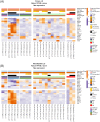Long-term spaceflight and the cardiovascular system
- PMID: 33391848
- PMCID: PMC7757439
- DOI: 10.1093/pcmedi/pbaa022
Long-term spaceflight and the cardiovascular system
Abstract
While early investigations into the physiological effects of spaceflight suggest the body's ability to reversibly adapt, the corresponding effects of long-term spaceflight (>6 months) are much less conclusive. Prolonged exposure to microgravity and radiation yields profound effects on the cardiovascular system, including a massive cephalad fluid translocation and altered arterial pressure, which attenuate blood pressure regulatory mechanisms and increase cardiac output. Also, central venous pressure decreases as a result of the loss of venous compression. The stimulation of baroreceptors by the cephalad shift results in an approximately 10%-15% reduction in plasma volume, with fluid translocating from the vascular lumen to the interstitium. Despite possible increases in cardiac workload, myocyte atrophy and notable, yet unexplained, alterations in hematocrit have been observed. Atrophy is postulated to result from shunting of protein synthesis from the endoplasmic reticulum to the mitochondria via mortalin-mediated action. While data are scarce regarding their causative agents, arrhythmias have been frequently reported, albeit sublethal, during both Russian and American expeditions, with QT interval prolongation observed in long, but not short duration, spaceflight. Exposure of the heart to the proton and heavy ion radiation of deep space has also been shown to result in coronary artery degeneration, aortic stiffness, carotid intima thickening via collagen-mediated action, accelerated atherosclerosis, and induction of a pro-inflammatory state. Upon return, long-term spaceflight frequently results in orthostatic intolerance and altered sympathetic responses, which can prove hazardous should any rapid mobilization or evacuation be required, and indicates that these cardiac risks should be especially monitored for future missions.
Keywords: aerospace medicine; cardiovascular system; microgravity; spaceflight.
© The Author(s) 2020. Published by Oxford University Press on behalf of the West China School of Medicine & West China Hospital of Sichuan University.
Figures
References
-
- Parin VV, Gazenko OG. Soviet experiments aimed at investigating the influence of space flight factors on the physiology of animals and man. Life Sci Space Res. 1963;1:113–127. - PubMed
Grants and funding
LinkOut - more resources
Full Text Sources

